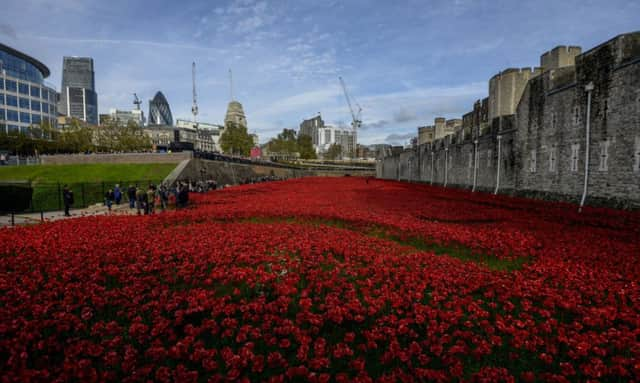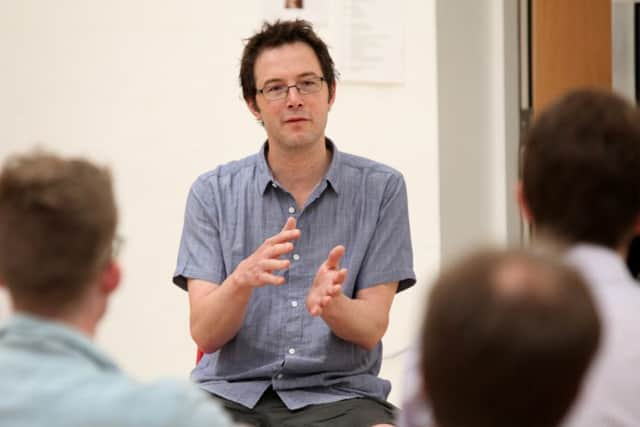From moat to Mermaid


Tom Piper knows only too well that everyone’s a critic. As a theatre designer who works regularly with the Royal Shakespeare Company, most of his harshest reviews have come from members of the public rather than paid professionals. Take the opening night of A Midsummer Night’s Dream in 1999. It was one of Piper’s first productions for the RSC, but before the first lines had even been uttered, the two women sitting in front had already decided they didn’t like what they were seeing.
“I heard one of them turn to the other and say ‘Well, they haven’t spent much on the set, have they?’” he laughs. “I could see where they were coming from. The set was really one big giant oval piece of wood, but I thought ‘Just you wait and see’.”
Advertisement
Hide AdAdvertisement
Hide AdOver the following three hours, that piece of wood was transformed. Things popped through it and grew round it and by the final act it had changed from a blank canvas to a riot of colour. Stark, minimal designs have become Piper’s stock in trade since he got his first job in British theatre with a production of Jack and the Beanstalk at the Tron Theatre in Glasgow in 1991.


“To me, a set has to be more than just a backdrop, it has to be part of the play and I guess I am known for my stripped back approach. I’ve just done The King’s Speech and as the show began its run I happened to be at a hotel close to the theatre. Again I was eavesdropping on a conversation between two obviously passionate fans of West End theatre and musicals in particular. I held my breathe when they began talking about The King’s Speech, but one of them said ‘You know what? It’s amazing, it just made me believe I was there in that room’. For me that’s the key to good set design. You don’t need huge sets, crammed with period detail, you just need to be able to conjure the idea of the place and the atmosphere of the place.”
That absolute self-belief in his work came in useful last year when Piper was drafted in to help realise the Blood Swept Lands and Sea of Red installation at the Tower of London. While the initial idea belonged to artist Paul Cummins, it was Piper who decided the ceramic poppies should cascade from the Tower windows like a river of blood and it was he who came up with the idea of having volunteers plant them.
“Paul had initially approached the Tower of London and they were really keen on the project but Deborah Shaw, who is head of creative programming at Historic Royal Palaces, felt it needed a theatrical edge. I knew Deborah through my work with the RSC and she asked whether I would be interested. I don’t think any of us realised the scale of the project, but having the poppies individually planted by 17,500 volunteers helped it to become a living work of art, rather than something which just popped up overnight.”
Advertisement
Hide AdAdvertisement
Hide AdThe first of the 888,246 poppies – each representing a British or Colonial serviceman killed in the First World War – was planted on July 17 and by the time the final one was put in place on November 11, the artwork had garnered worldwide attention. Most of the coverage was overwhelmingly positive, but the installation did have its critics. AA Gill, of the The Sunday Times, called it “impressive” but “curiously bland”, while the Guardian’s art critic, Jonathan Jones, described it as having a “false nobility” and being a “prettified and toothless” memorial. And as thousands queued each day to take photos on their mobile phones others wondered whether the moment of quiet reflection it was supposed to inspire had been lost.
“We wanted it to be accessible and we wanted it to be easy for people to understand. I knew people would ask whether I had a personal connection to the First World War and at first I wasn’t sure I did, but then my mum started talking about my great uncle who died out there. That was one of things which was good about the piece, it got people talking about the past.
“When I work in the theatre, at most 20,000 people will probably see what I’ve done, so having five million turn up to look at the poppies was quite strange and a little overwhelming. Of course there were people down there taking selfies, that’s what you get in the modern age, but I don’t think it detracted from the overall impression.”
Despite his success, when he was younger Piper says he had no intention of working in the theatre or even in the arts and when he entered Cambridge University it was after winning a place to study biology.
Advertisement
Hide AdAdvertisement
Hide Ad“In this country I do think we force children at an early age to decide whether they are arts or science and I plumped for science. I really enjoyed biology, but I had the rather naive idea that I would discover the cure for cancer overnight. When it became clear that wasn’t going to happen and that scientific research requires huge amounts of work, much of which goes unrecognised, I decided to think again.”
Mid-course he switched to art history and by then he was already spending much of his spare time making sets for friends involved in university productions, including a version of The Tempest directed by Sam Mendes.
“The first set I ever designed was when I was at school. It was basically a VW car suspended from the ceiling which at one point had to come crashing down onto the stage. The production ran for just two nights, which was fortunate as I don’t think the car would have lasted any more. However, it probably did hint at the scale of my ambition.
“Later I did do a post-graduate course in theatre design at the Slade School of Art, but I am largely self-taught and I think that has been beneficial. I never knew there were certain ways you were supposed to do things, I’ve just always felt my own way through.”
Advertisement
Hide AdAdvertisement
Hide AdMost recently Piper has been working on a stage adaptation of the Hans Christian Andersen tale Mermaid. A joint production between Shared Experience and Nottingham Playhouse, the story of how a mermaid rises up from beneath the waves on her 16th birthday comes to West Yorkshire Playhouse in Leeds next month and features what could be the worst nightmare of most theatre designers – water.
“Let’s just say we won’t be flooding the stage and if there is any water at all it will be minimal. Actually the real difficulty with this piece is not the setting, but the fact that the cast change characters so often and so quickly. While I obviously have ideas quite early on for how I’d like a production to look, it’s only when you start working with the director and get into the rehearsals that those ideas really take shape.”
Mermaid will be performed around a raised platform that will divide the stage between the real world and the sea beneath while movement rather than props will tell much of the action.
“For me less is more,” says Piper, whose most challenging project to date was designing the Histories Cycles for the RSC. Featuring eight plays, staged over two days and lasting more than 24 hours, his brief was to create one set to span the entire narrative. “That was a massive logistical challenge, but actually having so many constraints turned out to be quite liberating.”
Advertisement
Hide AdAdvertisement
Hide AdPiper admits that both his workshop and home are lightly littered with cast-off pieces from sets that didn’t quite work, but he says the key to being a good designer is admitting when you’re wrong.
“Often you have an idea which looks great on paper, but on the stage it can be too overwhelming or distracting. The thing about this job, as with most jobs, is the more successful you become, the higher up the ladder you climb then you tend to get more distant from the practical. Your hands become less dirty, but I like my hands to be a little dirty, I think it’s an important part of the process.
“A lot of people these days use 3D computer modelling, but it’s not something I’m very good at. I am a traditional in that I like to work with model boxes and I get someone else to translate them into the actual drawings. I’m a great believer in people being allowed to specialise rather than being forced to become a jack of all trades.”
He’s also learnt that you can’t please all of the people, all of the time. “The worst thing that has ever been said about my work, was ‘Tom Piper’s set has no sense of space, time or atmosphere’. It was from a review of A Month in the Country. I had it put on a T-shirt.”
• Mermaid, West Yorkshire Playhouse, Leeds, March 25 to 28, phone box office on 0113 213 7700, www.wyp.org.uk